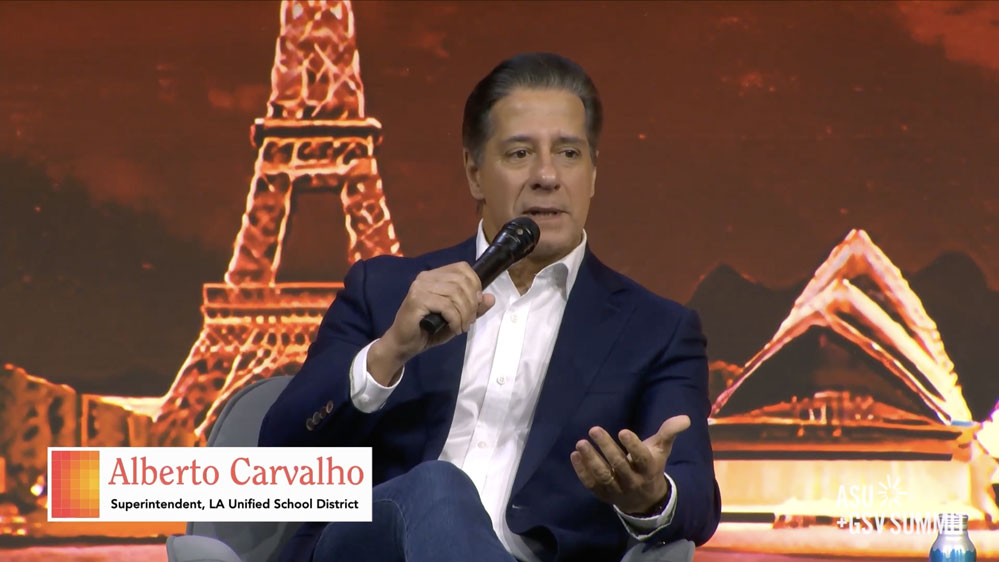Was Los Angeles Schools’ $6 Million AI Venture a Disaster Waiting to Happen?
The vision for what the much-hyped chatbot could do is ‘really not possible with where the technology is today,’ one insider says.

Get stories like this delivered straight to your inbox. Sign up for The 74 Newsletter
When news broke last month that Ed, the Los Angeles school district’s new, $6 million artificial intelligence chatbot, was in jeopardy — the startup that created it on the verge of collapse — many insiders in the ed tech world wondered the same thing: What took so long?
The AI bot, created by Boston-based AllHere Education, was launched March 20. But just three months later, AllHere posted on its website that a majority of its 50 or so employees had been furloughed due to its “current financial position.” A spokesperson for the Los Angeles district said company founder and CEO Joanna Smith-Griffin was no longer on the job. AllHere was up for sale, the district said, with several businesses interested in acquiring it.

The news was shocking and certainly bleak for the ed tech industry, but several observers say the partnership bit off more than it could chew, tech-wise — and that the ensuing blowup could hurt future AI investments.
Ed was touted as a powerful, easy-to-use online tool for students and parents to supplement classroom instruction, find assistance with kids’ academic struggles and help families navigate attendance, grades, transportation and other key issues, all in 100 languages and on their mobile phones.
But Amanda Bickerstaff, founder and CEO of AI for Education, a consulting and training firm, said that was an overreach.
“What they were trying to do is really not possible with where the technology is today,” she said. ”It’s a very broad application [with] multiple users — teachers, students, leaders and family members — and it pulled in data from multiple systems.”
What they were trying to do is really not possible with where the technology is today.
Amanda Bickerstaff, AI for Education
She noted that even a mega-corporation like McDonald’s had to trim its AI sails. The fast-food giant recently admitted that a small experiment using a chatbot to power drive-thru windows had resulted in a few fraught customer interactions, such as one in which a woman angrily tried to persuade the bot that she wanted a caramel ice cream as it added multiple stacks of butter to her order.
If McDonald’s, worth an estimated $178.6 billion, can’t get 100 drive-thrus to take lunch orders with generative AI, she said, the tech isn’t “where we need it to be.”
If anything, L.A. and AllHere did not seem worried about the project’s scale, even if industry insiders now say it was bound to under-deliver: Last spring, at a series of high-profile ed tech conferences, Smith-Griffin and Superintendent Alberto Carvalho showed off Ed widely, with Carvalho saying it would revolutionize students’ and parents’ relationships to school, “utilizing the data-rich environment that we have for every kid.”

In an interview with The 74 at the ASU+GSV Summit in San Diego in April, Carvalho said many students are not connected to school, “therefore they’re lost.” Ed, he promised, would change that, with a “significantly different approach” to communication from the district.
“We are shifting from a system of 540,000 students into 540,000 ‘schools of one,’” with personalization and individualization for each student, he said, and “meaningful connections with parents.”
Better communication with parents, he said, would help improve not just attendance but reading and math proficiency, graduation rates and other outcomes. “The question that needs to be asked is: Why have those resources not meaningfully connected with students and parents, and why have they not resulted in this explosive experience in terms of educational opportunity?”
Carvalho noted Ed’s ability to understand and communicate in about 100 different languages. And, he crowed, it “never goes to sleep” so it can answer questions 24/7. He called it “an entity that learns and relearns all the time and does nothing more, nothing less than adapt itself to you. I think that’s a game changer.”
But one experienced ed tech insider recalled hearing Carvalho speak about Ed at the conference in April and say it was already solving “all the problems” that big districts face. The insider, who asked not to be identified in order to speak freely about sensitive matters, found the remarks troubling. “The messaging was so wrong that at that point I basically started a stopwatch on how long it would take” for the effort to fail. “And I’m kind of amazed it’s been this long before it all fell apart. I feel badly about it, I really do, but it’s not a surprise.”
‘A high-risk proposition’
In addition to the deal’s dissolution, The 74 reported last week that a former senior director of software engineering at AllHere told district officials, L.A.’s independent inspector general’s office and state education officials that Ed processed student records in ways that likely ran afoul of the district’s own data privacy rules and put sensitive information at risk of being hacked — warnings that he said the agencies ignored.
AI for Education’s Bickerstaff said developers “have to take caution” when building these systems for schools, especially those like Ed that bring together such large sets of data under one application.
“These tools, we don’t know how they work directly,” she said. “We know they have bias. And we know they’re not reliable. We know they can be leaky. And so we have to be really careful, especially with kids that have protected data.”
Alex Spurrier, an associate partner with the education consulting firm Bellwether Education Partners, said what often happens is that district leaders “try to go really big and move really fast to adopt a new technology,” not fully appreciating that it’s “a really high risk proposition.”
While ed tech is rife with disaster stories of overpromising and disappointing results, Spurrier said, other districts dare to take a different approach, starting small, iterating and scaling up. In those cases, he said, disaster rarely follows.
Richard Culatta, CEO of the International Society for Technology in Education (ISTE), put it more bluntly: “Whenever a district says, ‘Our strategy around AI is to buy a tool,’ that’s a problem. When the district says, ‘For us, AI is a variety of tools and skills that we are working on together,’ that’s when I feel comfortable that we’re moving in the right direction.”
Whenever a district says, 'Our strategy around AI is to buy a tool,' that's a problem.
Richard Culatta, International Society for Technology in Education
Culatta suggested that since generative AI is developing and changing so rapidly, districts should use the next few months as “a moment of exploration — it’s a moment to bring in teachers and parents and students to give feedback,” he said. “It is not the moment for ribbon cutting.”
‘It’s about exploring’
Smith-Griffin founded AllHere in 2016 at Harvard University’s Innovation Labs. In an April interview with The 74, she said she originally envisioned it as a way to help school systems reduce chronic absenteeism through better communication with parents. Many interventions that schools rely on, such as phone calls, postcards and home visits, “tend to be heavily reliant on the sheer power of educators to solve system-wide issues,” she said.
A former middle-school math teacher, Smith-Griffin recalled, “I was one of those teachers who was doing phone calls, leaving voicemails, visiting my parents’ homes.”
AllHere pioneered text messaging “nudges,” electronic versions of postcard reminders to families that, in one key study, improved attendance modestly.
The company’s successful proposal for L.A., Smith-Griffin said, envisioned extending the attendance strategies while applying them to student learning “in the most disciplined way possible.”
“You nudge a parent around absences and they will tell you things ranging from, ‘My kid needs tutoring, my kid is struggling with math’ [to] ‘I struggle with reading,’” she said. AllHere went one step further, she said, bringing together “the full body of resources” that a school system can offer parents.
The district had high hopes for the chatbot, requiring it to focus on “eliminating opportunity gaps, promoting whole-child well-being, building stronger relationships with students and families, and providing accessible information,” according to the proposal.
In April, it was still in early implementation at 100 of the district’s lowest performing “priority” schools, serving about 55,000 students. LAUSD planned to roll out Ed for all families this fall. The district “unplugged” the chatbot on June 14, the Los Angeles Times reported last week, but a district spokesperson said L.A. “will continue making Ed available as a tool to its students and families and is closely monitoring the potential acquisition of AllHere.” The company did not immediately responded to queries about the chatbot or its future.
As for the apparent collapse of AllHere, speculation in the ed tech world is rampant.
In the podcast he co-hosts, education entrepreneur Ben Kornell said late last month, “My spidey sense basically goes to ‘Something’s not adding up here and there’s more to the story.’” He theorized a “critical failure point” that’s yet to emerge “because you don’t see things like this fall apart this quickly, this immediately” for such a small company, especially in the middle of a $6 million contract.
My spidey sense basically goes to 'Something's not adding up here and there's more to the story.'
Ben Kornell, education entrepreneur
Kornell said the possibilities fall into just a few categories: an accounting or financial misstep, a breakdown among AllHere’s staff, board and funders or “major customer payment issues.”
The district also may have withheld payment for undelivered products, but he said the sudden collapse of the company seemed unusual. “If you are headed towards a cash crisis, the normal thing to do would be: Go to your board, go to your funders, and get a bridge to get you through that period and land the plane.”
Bellwether’s Spurrier said L.A. deserves a measure of credit “for being willing to lean into AI technology and think about ways that it could work.” But he wonders whether the best use of generative AI at this moment will be found not in “revolutionizing instruction,” as L.A. has pursued, but elsewhere.
There's plenty of opportunities to think about how AI might help on the administrative side of things, or help folks that are kind of outside the classroom walls.
Alex Spurrier, Bellwether Education Partners
“There’s plenty of opportunities to think about how AI might help on the administrative side of things, or help folks that are kind of outside the classroom walls,” rather than focusing on changing how schools deliver instruction. “I think that’s the wrong place to start.”
ISTE’s Culatta noted that just down the road from Los Angeles, in Santa Ana, California, district officials there responded to the dawn of tools like ChatGPT and Google’s Gemini by creating evening classes for adults. “The parents come in and they talk about what AI is, how they should be thinking about it,” he said. “It’s about exploring. It’s about helping people build their skills.”
‘How are your financials?’
The fate of AllHere’s attendance work in districts nationwide isn’t clear at the moment. In one large district, the Prince George’s County, Maryland, Public Schools, near Washington, D.C., teachers piloted AllHere with 32 schools as far back as January 2020, spokeswoman Meghan Thornton said. The district added two more schools to the pilot in 2022, but AllHere notified the district on June 18 that, effective immediately, it wouldn’t be able to continue its services due to “unforeseen financial circumstances.”
District officials are now looking for another messaging system to replace AllHere “should it no longer be available,” Thornton said.
Bickerstaff said the field more broadly suffers from “a major, major overestimation of the capabilities of the technology to date.” L.A., she noted, is the nation’s second-largest school district, so even the pilot stage likely saw “very high” usage, raising its costs. She predicted a fast acquisition of AllHere, noting that they’d been looking for outside investment for several months.
As founder of the startup Magic School AI, which offers teachers tools to streamline their workload, Adeel Khan is no stranger to hustling for funding — and to competitors running out of money. But he said the news about AllHere and Ed was bad for the industry more broadly, leaving districts with questions about whether to partner with newer, untested companies.
“I see it as something that is certainly not great for the startup ecosystem,” he said.
I see (AllHere’s failure) as something that is certainly not great for the startup ecosystem.
Adeel Khan, Magic School AI
Even before the news about AllHere broke last month, Khan attended ISTE’s big national conference in Denver last month, where he talked to school district officials about prospective partnerships. “More than one time I was asked directly, ‘How are your financials?’” he recalled.
Usually technology directors ask about features and what a product can do for students, he said. But they’re beginning to realize that a failed product doesn’t just waste time and money. It damages reputations as well. “That is on the mind of buyers,” he said.
When school districts invest in new tech, he said, they’re not just committing to funding it for months or even years, but also to training teachers and others, so they want responsible growth.
“There’s a lot of disruption to K-12 when a product goes out of business,” Khan said. “So people remember this. They remember, ‘Hey, we committed to this product. We discovered it at ISTE two years ago and we loved it. It was great — and it’s not here anymore. And we don’t want to go through that again.’ ”
Get stories like these delivered straight to your inbox. Sign up for The 74 Newsletter

;)





